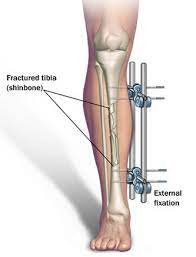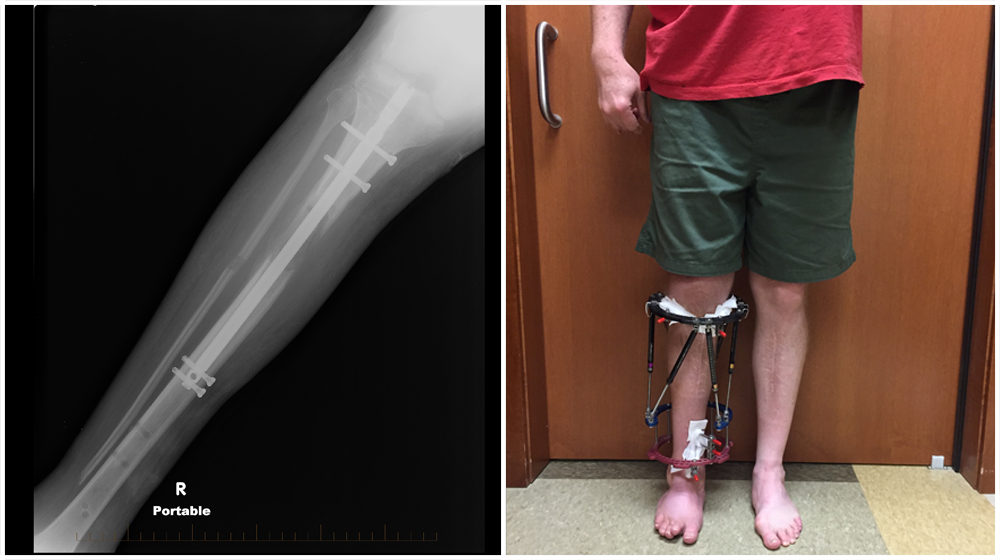Unlocking New Heights: A Comprehensive Guide to Limb Lengthening Surgery
In the quest for self-improvement and personal growth, some individuals explore medical procedures like limb lengthening surgery to enhance their stature and boost their confidence. This comprehensive guide dives into the world of limb lengthening surgery, shedding light on the procedure, its benefits, considerations, and the experiences of those who have undergone it. Whether you’re seeking to gain a few extra inches or simply curious about the process, this article will provide you with a detailed understanding of what limb lengthening surgery entails.

Understanding Limb Lengthening Surgery:
Limb lengthening surgery is a medical procedure designed to increase a person’s height through the controlled lengthening of bones, typically the legs. It involves the precise manipulation of bone growth to achieve the desired height. The procedure is performed by experienced orthopedic surgeons, often utilizing advanced techniques and devices. Two primary methods are commonly used: external fixators and internal devices.
External Fixators:
This technique involves the attachment of external devices to the patient’s limbs. These devices exert controlled tension on the bone, stimulating new bone growth at a controlled rate. The gradual stretching of bone tissue allows for the formation of new bone, effectively lengthening the limb.
Internal Devices:
Internal devices, such as intramedullary nails or rods, are surgically implanted within the bone. These devices provide stability and support during the lengthening process. They are often preferred for their relatively lower risk of complications compared to external fixators.

Benefits and Considerations:
Limb lengthening surgery offers a range of potential benefits, both physical and psychological. While the primary goal is to increase height, individuals who opt for this procedure often experience improved self-esteem and a greater sense of confidence. This boost in self-image can lead to enhanced social interactions, increased opportunities, and a more positive outlook on life.
However, before embarking on the limb-lengthening journey, it’s crucial to consider several important factors:
Thorough Medical Evaluation:
Prospective candidates undergo comprehensive medical assessments to determine their suitability for the procedure. Medical history, bone health, and overall physical condition are assessed to ensure a successful outcome.
Realistic Expectations:
Managing expectations is paramount. While limb lengthening surgery can provide noticeable height gains, it’s essential to have realistic expectations and understand that the process requires time, commitment, and patience.
Potential Risks and Complications:
As with any surgical procedure, limb lengthening surgery carries inherent risks. These may include infection, nerve damage, bone deformities, and lengthening disparities between limbs. Choosing a skilled and experienced surgeon can significantly minimize these risks.
Financial and Time Commitment:
Limb lengthening surgery demands a financial investment and considerable time commitment. The lengthening process itself can take several months, followed by a period of recovery and rehabilitation.
Psychological Preparedness:
It’s crucial for individuals to be emotionally prepared for the physical and psychological challenges that come with the procedure. The recovery phase can be demanding, requiring dedication to physical therapy and a positive mindset.
Before the Procedure:
Embarking on the journey of limb lengthening surgery involves careful preparation to ensure a smooth and successful experience. Before undergoing the procedure, individuals are required to follow a series of steps:
Consultations and Assessments:
The process begins with thorough consultations with orthopedic surgeons who specialize in limb lengthening. These consultations involve detailed discussions about the procedure, expected outcomes, and potential risks. Medical history is reviewed, and a physical examination is conducted to assess overall health.
Imaging and Measurements:
Precise measurements and imaging scans are taken to evaluate bone length and density. This information helps surgeons plan the lengthening process and choose the appropriate technique and devices.
Preoperative Tests:
A battery of tests, including blood work and X-rays, may be conducted to ensure the individual’s overall health and suitability for surgery. These tests help identify any preexisting conditions that could impact the procedure.
Psychological Evaluation:
Some medical professionals may recommend a psychological assessment to gauge the individual’s mental preparedness for the procedure and recovery. Coping strategies and emotional support may be discussed.
Informed Consent:
Prior to proceeding with the surgery, individuals are presented with detailed information about the procedure, its potential risks, benefits, and alternatives. Informed consent ensures that individuals are fully aware of what to expect and can make educated decisions.
Preoperative Instructions:
Patients receive specific instructions to follow in the days leading up to the surgery. These may include guidelines on fasting, medications to avoid, and preoperative hygiene practices.
Physical Preparation:
Engaging in regular exercise, maintaining a healthy diet, and refraining from smoking can contribute to a smoother surgery and recovery process.
During the Procedure:
The limb lengthening surgery itself is a meticulously orchestrated process that involves several stages, each contributing to the gradual and controlled lengthening of the bones. Here’s an overview of what individuals can expect during the procedure:
Anesthesia:
The surgery begins with the administration of anesthesia to ensure the patient’s comfort throughout the procedure. This may involve general anesthesia or regional anesthesia, depending on the surgeon’s recommendation and the patient’s preference.
Incision and Access:
A small incision is made at the designated area, typically near the bone that will be lengthened. The surgeon carefully accesses the bone and surrounding tissues.
Device Placement:
Depending on the chosen technique, external fixators or internal devices are introduced. External fixators involve the attachment of metal frames outside the body, while internal devices are inserted within the bone.
Bone Osteotomy:
In most cases, a controlled osteotomy (bone cut) is performed to allow for the lengthening process. The bone is carefully cut, and the gap created is what will be gradually expanded over time.
Gradual Lengthening:
The lengthening process begins after a brief initial stabilization period. For external fixators, adjustments are made regularly to gradually increase the gap between bone segments. Internal devices may feature remote-controlled mechanisms for lengthening.
New Bone Formation:
As the bone segments are gradually separated, the body responds by initiating a natural healing process. New bone tissue forms in the gap, effectively lengthening the bone.
Monitoring and Healing:
Throughout the lengthening phase, patients undergo regular medical check-ups and imaging scans to monitor progress. The healing process is closely observed to ensure optimal bone growth.
Consolidation Phase:
Once the desired length is achieved, a consolidation phase follows. This phase allows the newly formed bone to strengthen and solidify, ensuring long-term stability.
Recovery and Rehabilitation:
The journey through limb lengthening surgery extends beyond the operating room, encompassing a phase of recovery and rehabilitation that is essential for achieving optimal results. This phase requires patience, commitment, and collaboration between the individual, medical professionals, and caregivers.
Immediate Postoperative Care:
Following surgery, patients are closely monitored as they awaken from anesthesia. Pain management measures are administered, and the surgical site is carefully observed for any signs of infection or complications.
Immobilization:
In the initial days after surgery, patients may be required to use crutches, braces, or other assistive devices to support the limb and prevent undue stress on the lengthening area. Immobilization helps safeguard the healing process.
Physical Therapy:
Engaging in guided physical therapy is a cornerstone of the recovery process. Physical therapists design tailored exercises to help maintain joint mobility, strengthen muscles, and promote circulation. Patients gradually regain strength and flexibility.
Weight-Bearing Progression:
As healing progresses, the weight-bearing status of the limb is gradually increased. This is a carefully managed process to ensure that the bone can withstand the pressure of standing and walking.
Device Removal:
Once the bone has adequately healed and achieved the desired length, any external fixators or internal devices may be removed through a separate surgical procedure. This step marks a significant milestone in the recovery journey.
Continued Monitoring:
Regular follow-up appointments with medical professionals are essential during the recovery phase. Imaging scans and physical assessments track bone healing and ensure that any potential complications are promptly addressed.
Psychological Support:
Coping with the physical and emotional challenges of limb lengthening surgery requires psychological resilience. Mental health support, counseling, and peer groups can offer valuable assistance in managing the emotional aspects of the journey.
Gradual Return to Activities:
As bone strength improves and mobility is regained, patients gradually return to their usual activities. It’s important to follow the guidance of medical professionals and avoid pushing the body too hard too soon.
Frequently Asked Questions (FAQs)
Q: What is limb lengthening surgery?
A: Limb lengthening surgery is a medical procedure designed to increase a person’s height by gradually lengthening bones, often in the legs. It involves controlled bone growth and is performed by orthopedic surgeons.
Q: Who is a suitable candidate for limb lengthening surgery?
A: Suitable candidates typically include individuals with a desire to gain height, realistic expectations, good overall health, and appropriate bone conditions. A thorough medical evaluation is essential.
Q: How is the surgery performed?
A: The surgery involves making a controlled bone cut, inserting devices for gradual lengthening, and allowing new bone tissue to form. External fixators or internal devices may be used, and adjustments are made over time.
Q: What are the potential risks and complications?
A: Risks may include infection, nerve damage, bone deformities, and lengthening disparities. Choosing an experienced surgeon and following post-operative care guidelines can minimize these risks.
Q: How long does the recovery process take?
A: Recovery varies, but it can extend several months. Patients undergo physical therapy, weight-bearing progression, and medical check-ups to ensure proper healing and bone strength.
Q: Will the results be permanent?
A: Yes, the results of limb lengthening surgery are permanent. Once the bone has fully healed and consolidated, the newly achieved height is maintained.
Q: What are the alternatives to surgical height enhancement?
A: Non-surgical alternatives include height-enhancing exercises, therapies, and footwear. These options may provide modest height gains without surgical intervention.
Q: Are there age restrictions for limb lengthening surgery?
A: Age restrictions vary, but most surgeons prefer candidates whose bones have stopped growing. Generally, candidates should be in their late teens or older.
Q: How much does limb lengthening surgery cost?
A: Costs vary based on factors such as the chosen technique, surgeon’s experience, and geographical location. It’s important to obtain detailed cost estimates during consultations.
Q: How can I prepare for limb lengthening surgery?
A: Preparing involves consultations with surgeons, medical evaluations, imaging scans, and physical assessments. Following preoperative instructions and maintaining good health are key.
Conclusion
The realm of limb lengthening surgery offers a fascinating intersection of medical science, personal aspirations, and transformative journeys. As we’ve explored throughout this comprehensive guide, the decision to undergo limb lengthening surgery involves careful consideration, dedication, and a willingness to embrace the challenges and rewards that accompany the process.




